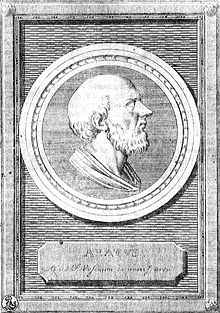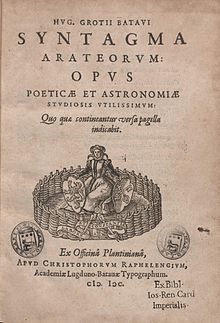Aratos from Soloi
Aratos von Soloi ( Greek Ἄρατος Áratos , German also Arat ; * approx. 310 BC ; † 245 BC ) was an ancient Greek author.
Aratos was born in Soloi in Cilicia and came from a noble family. His studies took him to Athens . There he dealt with stoic philosophy; In contrast to modern philosophy, this included natural science, which was called physics. He lived for a long time at the court of Antigonus II Gonatas in Macedonia and in Syria with Antiochus I.
From Aratos only the didactic poem Φαινόμενα Phainomena ("heavenly phenomena"), which became famous in antiquity, is preserved, which describes the starry sky in 1154 hexameters and is based on the astronomical teaching of Eudoxus by Knidos . Aratos gave his brittle material more life through allusions to star tales, katasterismoi . In a second part he teaches about weather signs, "Diosemeia". The poem became famous because Aratos overcame the discrepancy between the brittle subject matter and beautiful presentation, although he had no knowledge of astronomy.
Aratos' work found numerous imitators who tried to compete with the original. The most famous Latin versions come from Cicero , Germanicus ( Aratea des Germanicus ) and Avienus . Since Aratos' text is not easy to understand, it was accompanied by explanations ( scholias ) in ancient times . In the Latin translations of Cicero and Germanicus in particular, Aratos influenced people's knowledge as a textbook, so to speak. Many of the modern constellations can be traced back to these versions and owe their canonization to Aratos, which also continued to have an effect in the Syntaxis mathematica (usually called Almagest for short ) of Klaudios Ptolemaios (2nd century) via the Arab-Moorish tradition.
The Acts of the Apostles makes the Apostle Paul from the prologue of Aratus' Phainomena quote: "We are his [Aratos: of Zeus; Paul means: God's] sex. "
The moon crater Aratus is named after Aratos von Soloi.
Editions and translations
- Robin Hard (translator): Eratosthenes and Hyginus: Constellation Myths with Aratus's Phaenomena . Oxford 2015.
- Jean Martin (Ed.): Aratos: Phénomènes. Greek-French, 2 vols., Paris 1998.
- Douglas Kidd (Ed.): Aratus: Phaenomena. Greek-English, Cambridge 1997.
- Jean Martin (Ed.): Scholia in Aratum vetera. Stuttgart 1974.
- Manfred Erren (Ed.): Aratos: Phainomena. Constellations and weather signs. Greek-German, Munich 1971. (New edition: Düsseldorf 2009)
- Albert Schott (transl.): Aratos: constellations and weather signs. With notes by Robert Boeker, Munich 1958.
- Alexander William Mair , Gilbert Robinson Mair (transl.): Callimachus: Hymns and Epigrams / Lycophron: Alexandra / Aratus: Phaenomena. Greek-English, Cambridge (MA) 1921.
literature
Overview representations
- Patrick Robiano, Jean-Pierre Mahé : Aratos de Soles. In: Richard Goulet (ed.): Dictionnaire des philosophes antiques. Volume 1, CNRS, Paris 1989, ISBN 2-222-04042-6 , pp. 322-325 (also deals with the Armenian tradition); Addendum to the iconography by François Queyrel in the volume Supplément , Paris 2003, ISBN 2-271-06175-X , p. 77 f.
- Evina Sistakou : Arat. In: Bernhard Zimmermann , Antonios Rengakos (Hrsg.): Handbook of the Greek literature of antiquity. Volume 2: The Literature of the Classical and Hellenistic Period. CH Beck, Munich 2014, ISBN 978-3-406-61818-5 , pp. 126-133.
Investigations
- Manfred Erren : The Phainomena des Aratos von Soloi, investigations into the understanding of facts and meaning. Steiner, Wiesbaden 1967.
- Christos Fakas: The Hellenistic Hesiod, Arat's “Phainomena” and the tradition of the ancient teaching repertoire. Reichert, Wiesbaden 2001, ISBN 3-89500-211-9 .
reception
- Florian Hurka: Arat and Aratea. In: Christine Walde (Ed.): The reception of ancient literature. Kulturhistorisches Werklexikon (= Der Neue Pauly . Supplements. Volume 7). Metzler, Stuttgart / Weimar 2010, ISBN 978-3-476-02034-5 , Sp. 69-75.
Web links
- Literature by and about Aratos von Soloi in the catalog of the German National Library
- Phainomena , Greek text from the Bibliotheca Augustana
- Phainomena , English translation on Theoi.com
- Edward Poste: The skies and Weather-forecasts of Aratus , 1880 ( digitized )
- Johann Heinrich Voss : Des Aratos star apparitions and weather signs , 1824 ( digitized version )
- Ernst Maass : Arati Phaenomena , 1893 ( digitized version )
Remarks
| personal data | |
|---|---|
| SURNAME | Aratos from Soloi |
| ALTERNATIVE NAMES | Aratos; Aratus; Arate; Ἄρατος (Greek) |
| BRIEF DESCRIPTION | Greek author |
| DATE OF BIRTH | around 310 BC Chr. |
| PLACE OF BIRTH | Soloi |
| DATE OF DEATH | 245 BC Chr. |

